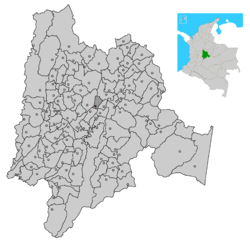
Tabio
Encyclopedia

Colombia
Colombia, officially the Republic of Colombia , is a unitary constitutional republic comprising thirty-two departments. The country is located in northwestern South America, bordered to the east by Venezuela and Brazil; to the south by Ecuador and Peru; to the north by the Caribbean Sea; to the...
in the department
Departments of Colombia
Colombia is an unitary republic formed by thirty-two departments and a Capital District . Each department has a Governor and a Department Assembly , elected by popular vote for a four-year period. The governor cannot be re-elected in consecutive periods...
of Cundinamarca
Cundinamarca Department
- Origin of the name :The name of Cundinamarca comes from Kundur marqa, an indigenous expression, probably derived from Quechua. Meaning "Condor's Nest", it was used in pre-Columbian times by the natives of the Magdalena Valley to refer to the nearby highlands....
. It is located at 45 km (28 mi) from Bogotá
Bogotá
Bogotá, Distrito Capital , from 1991 to 2000 called Santa Fé de Bogotá, is the capital, and largest city, of Colombia. It is also designated by the national constitution as the capital of the department of Cundinamarca, even though the city of Bogotá now comprises an independent Capital district...
. The population was 20,714 at 2005. The town was officially founded April 8, 1603, by Diego Gómez de Mena, on grounds that were the property of the native muisca
Muisca
Muisca was the Chibcha-speaking tribe that formed the Muisca Confederation of the central highlands of present-day Colombia. They were encountered by the Spanish Empire in 1537, at the time of the conquest...
people who inhabited the area.
History
The name Tabio comes from the Chibcha word “Teib,” meaning “dent” or “hole,” and which referred to its geographical location, next to the mouth of the Rio Frio river (also called Sinca). Muisca people occupied the current location of Tabio before the Spanish conquest, and were largely devoted to agriculture. The Muisca tribe comprised two confederations of small tribes, the Hunza of the northern area, whose sovereign was called Zaque, and the Bacatá of the southern area, whose sovereign was the Zipa, and which included the territory of Tabio.The natural hot springs in Tabio were famous among the muisca people, and they were said to have a temple there devoted to the Goddess of Waters. Under the Spanish conquest, the native muisca were expropriated and the area was put under a colonial rule that issued the foundation of Tabio in 1603.
Economy
Secondary and tertiary economic sectors are relatively underdeveloped in Tabio. Main industrial crops are devoted to floricultureFloriculture
Floriculture, or flower farming, is a discipline of horticulture concerned with the cultivation of flowering and ornamental plants for gardens and for floristry, comprising the floral industry...
. Potatoes, corn, peas, and carrots are also cultivated.
Tourism
Tabio is well known for its natural hot springs, which are said to have therapeutic properties. It is also known for the annual festival of Torbellino, a traditional Andean Colombian dance.External links
- http://tabio-cundinamarca.gov.co/index.shtml Official web site.

